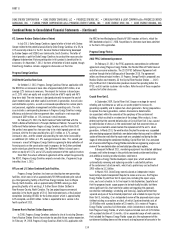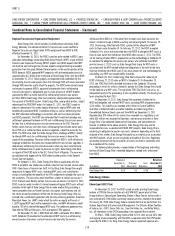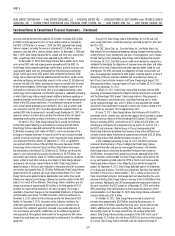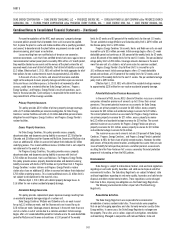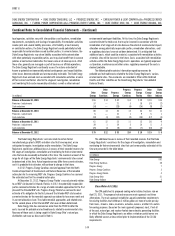Duke Energy 2012 Annual Report Download - page 159
Download and view the complete annual report
Please find page 159 of the 2012 Duke Energy annual report below. You can navigate through the pages in the report by either clicking on the pages listed below, or by using the keyword search tool below to find specific information within the annual report.
139
PART II
Combined Notes to Consolidated Financial Statements – (Continued)
DUKE ENERGY CORPORATION • DUKE ENERGY CAROLINAS, LLC • PROGRESS ENERGY, INC. • CAROLINA POWER & LIGHT COMPANY d/b/a PROGRESS ENERGY
CAROLINAS, INC. • FLORIDA POWER CORPORATION d/b/a PROGRESS ENERY FLORIDA, INC. • DUKE ENERGY OHIO, INC. • DUKE ENERGY INDIANA, INC.
new cost estimate for the IGCC project of $2.35 billion (including $125 million
of AFUDC) and for approval of plans to study carbon capture as required by
the IURC’s CPCN order. On January 7, 2009, the IURC approved Duke Energy
Indiana’s request, including the new cost estimate of $2.35 billion, and cost
recovery associated with a study on carbon capture. On November 3, 2008 and
May 1, 2009, Duke Energy Indiana fi led its second and third semi-annual IGCC
riders, respectively, both of which were approved by the IURC in full.
On November 24, 2009, Duke Energy Indiana fi led a petition for its fourth
semi-annual IGCC rider and ongoing review proceeding with the IURC. As
Duke Energy Indiana experienced design modifi cations, quantity increases and
scope growth above what was anticipated from the preliminary engineering
design, capital costs to the IGCC project were anticipated to increase. Duke
Energy Indiana forecasted that the additional capital cost items would use the
remaining contingency and escalation amounts in the current $2.35 billion cost
estimate and add $150 million, excluding the impact associated with the need
to add more contingency. Duke Energy Indiana did not request approval of an
increased cost estimate in the fourth semi-annual update proceeding; rather,
Duke Energy Indiana requested, and the IURC approved, a subdocket proceeding
in which Duke Energy Indiana would present additional evidence regarding an
updated estimated cost for the IGCC project and in which a more comprehensive
review of the IGCC project could occur. The evidentiary hearing for the fourth
semi-annual update proceeding was held April 6, 2010, and an interim order
was received on July 28, 2010. The order approved the implementation of an
updated IGCC rider to recover costs incurred through September 30, 2009. The
approvals were on an interim basis pending the outcome of the sub-docket
proceeding involving the revised cost estimate as discussed further below.
On April 16, 2010, Duke Energy Indiana fi led a revised cost estimate
for the IGCC project refl ecting an estimated cost increase of $530 million.
Duke Energy Indiana requested approval of the revised cost estimate of
$2.88 billion (including $160 million of AFUDC), and for continuation of the
existing cost recovery treatment. A major driver of the cost increase included
quantity increases and design changes, which impacted the scope, productivity
and schedule of the IGCC project. On September 17, 2010, an agreement
was reached with the Indiana Offi ce of Utility Consumer Counselor (OUCC),
Duke Energy Indiana Industrial Group and Nucor Steel Indiana to increase
the authorized cost estimate of $2.35 billion to $2.76 billion, and to cap the
project’s costs that could be passed on to customers at $2.975 billion. Any
construction cost amounts above $2.76 billion would be subject to a prudence
review similar to most other rate base investments in Duke Energy Indiana’s
next general rate increase request before the IURC. Duke Energy Indiana
agreed to accept a 150 basis point reduction in the equity return for any project
construction costs greater than $2.35 billion. Additionally, Duke Energy Indiana
agreed not to fi le for a general rate case increase before March 2012. Duke
Energy Indiana also agreed to reduce depreciation rates earlier than would
otherwise be required and to forego a deferred tax incentive related to the IGCC
project. As a result of the settlement, Duke Energy Indiana recorded a pre-tax
charge to earnings of approximately $44 million in the third quarter of 2010
to refl ect the impact of the reduction in the return on equity. The charge is
recorded in Impairment charges on the Consolidated Statements of Operations
and Comprehensive Income. The IURC convened a technical conference on
November 3, 2010, related to the continuing need for the Edwardsport IGCC
facility. On December 9, 2010, the parties to the settlement withdrew the
settlement agreement to provide an opportunity to assess whether and to
what extent the settlement agreement remained a reasonable allocation of
risks and rewards and whether modifi cations to the settlement agreement
were appropriate. Management determined that the approximate $44 million
charge discussed above was not impacted by the withdrawal of the settlement
agreement.
During 2010, Duke Energy Indiana fi led petitions for its fi fth and sixth
semi-annual IGCC riders. Evidentiary hearings were held on April 24, 2012 and
April 25, 2012.
The CAC, Sierra Club, Inc., Save the Valley, Inc., and Valley Watch, Inc.
fi led motions for two subdocket proceedings alleging improper communications,
undue infl uence, fraud, concealment and gross mismanagement, and a request
for fi eld hearing in this proceeding. Duke Energy Indiana opposed the requests.
On February 25, 2011, the IURC issued an order which denied the request for a
subdocket to investigate the allegations of improper communications and undue
infl uence at this time, fi nding there were other agencies better suited for such
investigation. The IURC also found that allegations of fraud, concealment and
gross mismanagement related to the IGCC project should be heard in a Phase II
proceeding of the cost estimate subdocket and set evidentiary hearings on
both Phase I (cost estimate increase) and Phase II beginning in August 2011.
After procedural delays, hearings began on Phase I on October 26, 2011 and on
Phase II on November 21, 2011.
On March 10, 2011, Duke Energy Indiana fi led testimony with the IURC
proposing a framework designed to mitigate customer rate impacts associated
with the Edwardsport IGCC project. Duke Energy Indiana’s fi ling proposed a
cap on the project’s construction costs, (excluding fi nancing costs), which
can be recovered through rates at $2.72 billion. It also proposed rate-related
adjustments that would lower the overall customer rate increase related to the
project from an average of 19% to approximately 16%.
On June 27, 2011, Duke Energy Indiana fi led testimony with the IURC in
connection with its seventh semi-annual rider request which included an update
on the current cost forecast of the Edwardsport IGCC project. The updated
forecast, excluding AFUDC, increased from $2.72 billion to $2.82 billion, not
including any contingency for unexpected start-up events. On June 30, 2011,
the OUCC and intervenors fi led testimony in Phase I recommending that
Duke Energy Indiana be disallowed cost recovery of any of the additional cost
estimate increase above the previously approved cost estimate of $2.35 billion.
Duke Energy Indiana fi led rebuttal testimony on August 3, 2011.
In the subdocket proceeding, on July 14, 2011, the OUCC and certain
intervenors fi led testimony in Phase II alleging that Duke Energy Indiana
concealed information and grossly mismanaged the project, and therefore
Duke Energy Indiana should only be permitted to recover from customers
$1.985 billion, the original IGCC project cost estimate approved by the IURC.
Other intervenors recommended that Duke Energy Indiana not be able to rely
on any cost recovery granted under the CPCN or the fi rst cost increase order.
Duke Energy Indiana believes it has diligently and prudently managed the
project. On September 9, 2011, Duke Energy defended against the allegations
in its responsive testimony. The OUCC and intervenors fi led their fi nal rebuttal
testimony in Phase II on or before October 7, 2011, making similar claims of
fraud, concealment and gross mismanagement and recommending the same
outcome of limiting Duke Energy Indiana’s recovery to the $1.985 billion initial
cost estimate. Additionally, the CAC recommended that recovery be limited to
the costs incurred on the IGCC project as of November 30, 2009, with further
IURC proceedings to be held to determine the fi nancial consequences of this
recommendation. As of November 30, 2009, Duke Energy Indiana estimated it
had committed costs of $1.6 billion.
On October 19, 2011, Duke Energy Indiana revised its project cost
estimate from approximately $2.82 billion, excluding fi nancing costs, to
approximately $2.98 billion, excluding fi nancing costs. The revised estimate
refl ects additional cost pressures resulting from quantity increases and
the resulting impact on the scope, productivity and schedule of the IGCC
project. Duke Energy Indiana previously proposed to the IURC a cost cap of
approximately $2.72 billion, plus the actual AFUDC that accrues on that amount.
As a result, Duke Energy Indiana recorded a pre-tax impairment charge of







